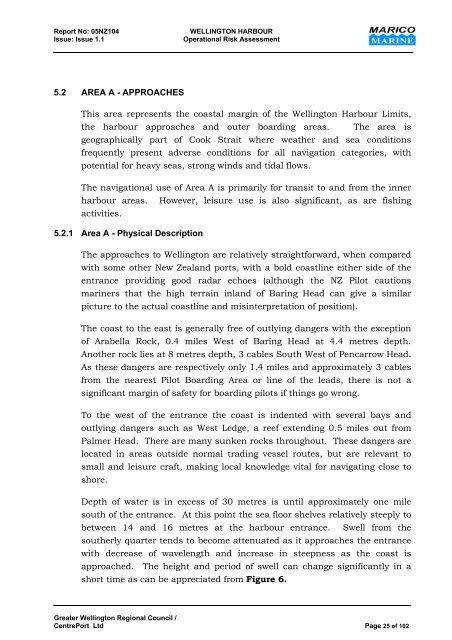MARICO Marine NZ Limited WELLINGTON HARBOUR PORT AND ...
MARICO Marine NZ Limited WELLINGTON HARBOUR PORT AND ...
MARICO Marine NZ Limited WELLINGTON HARBOUR PORT AND ...
You also want an ePaper? Increase the reach of your titles
YUMPU automatically turns print PDFs into web optimized ePapers that Google loves.
Report No: 05<strong>NZ</strong>104 <strong>WELLINGTON</strong> <strong>HARBOUR</strong><br />
Issue: Issue 1.1 Operational Risk Assessment<br />
5.2 AREA A - APPROACHES<br />
This area represents the coastal margin of the Wellington Harbour Limits,<br />
the harbour approaches and outer boarding areas. The area is<br />
geographically part of Cook Strait where weather and sea conditions<br />
frequently present adverse conditions for all navigation categories, with<br />
potential for heavy seas, strong winds and tidal flows.<br />
The navigational use of Area A is primarily for transit to and from the inner<br />
harbour areas. However, leisure use is also significant, as are fishing<br />
activities.<br />
5.2.1 Area A - Physical Description<br />
The approaches to Wellington are relatively straightforward, when compared<br />
with some other New Zealand ports, with a bold coastline either side of the<br />
entrance providing good radar echoes (although the <strong>NZ</strong> Pilot cautions<br />
mariners that the high terrain inland of Baring Head can give a similar<br />
picture to the actual coastline and misinterpretation of position).<br />
The coast to the east is generally free of outlying dangers with the exception<br />
of Arabella Rock, 0.4 miles West of Baring Head at 4.4 metres depth.<br />
Another rock lies at 8 metres depth, 3 cables South West of Pencarrow Head.<br />
As these dangers are respectively only 1.4 miles and approximately 3 cables<br />
from the nearest Pilot Boarding Area or line of the leads, there is not a<br />
significant margin of safety for boarding pilots if things go wrong.<br />
To the west of the entrance the coast is indented with several bays and<br />
outlying dangers such as West Ledge, a reef extending 0.5 miles out from<br />
Palmer Head. There are many sunken rocks throughout. These dangers are<br />
located in areas outside normal trading vessel routes, but are relevant to<br />
small and leisure craft, making local knowledge vital for navigating close to<br />
shore.<br />
Depth of water is in excess of 30 metres is until approximately one mile<br />
south of the entrance. At this point the sea floor shelves relatively steeply to<br />
between 14 and 16 metres at the harbour entrance. Swell from the<br />
southerly quarter tends to become attenuated as it approaches the entrance<br />
with decrease of wavelength and increase in steepness as the coast is<br />
approached. The height and period of swell can change significantly in a<br />
short time as can be appreciated from Figure 6.<br />
Greater Wellington Regional Council /<br />
CentrePort Ltd Page 25 of 102
















